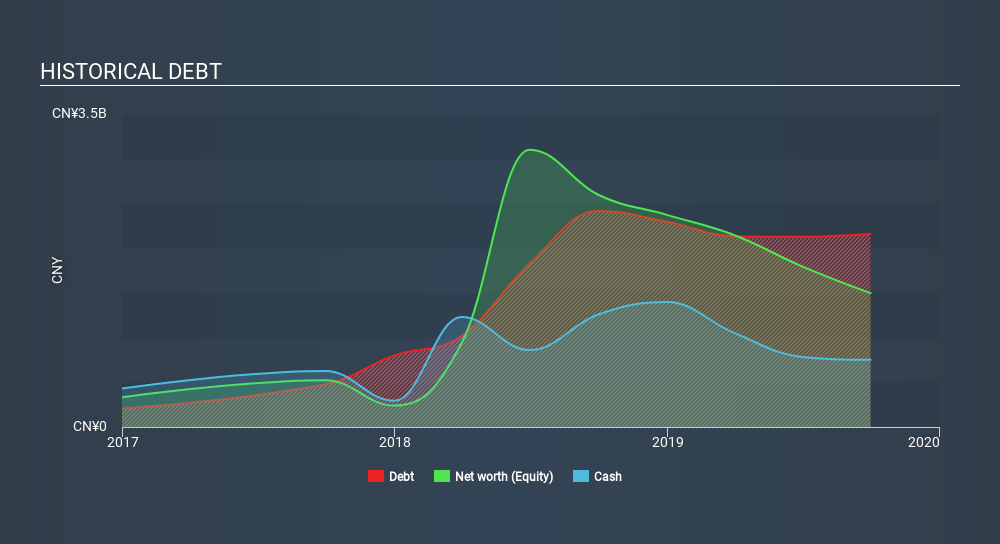- United States
- /
- Specialty Stores
- /
- NasdaqGS:UXIN
Health Check: How Prudently Does Uxin (NASDAQ:UXIN) Use Debt?
Warren Buffett famously said, 'Volatility is far from synonymous with risk.' It's only natural to consider a company's balance sheet when you examine how risky it is, since debt is often involved when a business collapses. We can see that Uxin Limited (NASDAQ:UXIN) does use debt in its business. But is this debt a concern to shareholders?
When Is Debt A Problem?
Debt assists a business until the business has trouble paying it off, either with new capital or with free cash flow. Ultimately, if the company can't fulfill its legal obligations to repay debt, shareholders could walk away with nothing. While that is not too common, we often do see indebted companies permanently diluting shareholders because lenders force them to raise capital at a distressed price. Of course, debt can be an important tool in businesses, particularly capital heavy businesses. When we think about a company's use of debt, we first look at cash and debt together.
View our latest analysis for Uxin
What Is Uxin's Debt?
As you can see below, Uxin had CN¥2.16b of debt at September 2019, down from CN¥2.42b a year prior. However, because it has a cash reserve of CN¥750.6m, its net debt is less, at about CN¥1.41b.

A Look At Uxin's Liabilities
The latest balance sheet data shows that Uxin had liabilities of CN¥3.35b due within a year, and liabilities of CN¥2.12b falling due after that. Offsetting these obligations, it had cash of CN¥750.6m as well as receivables valued at CN¥497.5m due within 12 months. So its liabilities outweigh the sum of its cash and (near-term) receivables by CN¥4.22b.
When you consider that this deficiency exceeds the company's CN¥3.61b market capitalization, you might well be inclined to review the balance sheet intently. In the scenario where the company had to clean up its balance sheet quickly, it seems likely shareholders would suffer extensive dilution. The balance sheet is clearly the area to focus on when you are analysing debt. But ultimately the future profitability of the business will decide if Uxin can strengthen its balance sheet over time. So if you're focused on the future you can check out this free report showing analyst profit forecasts.
In the last year Uxin wasn't profitable at an EBIT level, but managed to grow its revenue by 153%, to CN¥3.8b. So there's no doubt that shareholders are cheering for growth
Caveat Emptor
While we can certainly savour Uxin's tasty revenue growth, its negative earnings before interest and tax (EBIT) leaves a bitter aftertaste. Indeed, it lost a very considerable CN¥1.4b at the EBIT level. Considering that alongside the liabilities mentioned above make us nervous about the company. It would need to improve its operations quickly for us to be interested in it. For example, we would not want to see a repeat of last year's loss of CN¥1.5b. In the meantime, we consider the stock to be risky. When analysing debt levels, the balance sheet is the obvious place to start. But ultimately, every company can contain risks that exist outside of the balance sheet. To that end, you should learn about the 3 warning signs we've spotted with Uxin (including 1 which is is a bit unpleasant) .
If you're interested in investing in businesses that can grow profits without the burden of debt, then check out this free list of growing businesses that have net cash on the balance sheet.
If you spot an error that warrants correction, please contact the editor at editorial-team@simplywallst.com. This article by Simply Wall St is general in nature. It does not constitute a recommendation to buy or sell any stock, and does not take account of your objectives, or your financial situation. Simply Wall St has no position in the stocks mentioned.
We aim to bring you long-term focused research analysis driven by fundamental data. Note that our analysis may not factor in the latest price-sensitive company announcements or qualitative material. Thank you for reading.
About NasdaqGS:UXIN
Uxin
An investment holding company, operates as a used car retailer in the People’s Republic of China.
Limited growth with very low risk.
Similar Companies
Market Insights
Community Narratives



